Block Island is a popular place for seals. Here's what happens when one needs rescuing.
Reports of a seal with fishing line wrapped around its tail had been coming in for days, with Block Island beachgoers texting photos of the struggling gray seal to the animal hotline at Connecticut's Mystic Aquarium.
Sarah Callan, the Animal Rescue Program manager, desperately wanted to find this seal. Every report goes directly to her cellphone, so she knew exactly what the situation was looking like for the juvenile.
And it wasn’t great.
The biggest problem was the location.
The reports were all coming from the northern tip of Block Island, where over the last several years a few hundred seals have taken up permanent residence. The seals like it because it's remote, a three-quarter-mile walk from the nearest parking lot to where they sun themselves and swim in the Atlantic.
Three-quarters of a mile is both far and not that far.
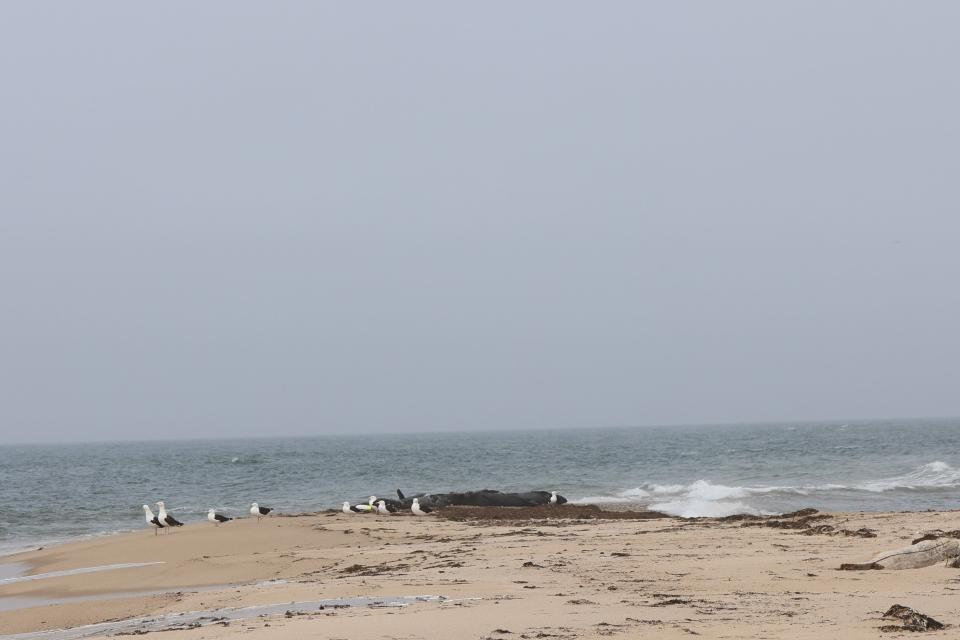
It’s not far enough to deter a steady stream of walkers from making their way to the point – walkers who don’t always know about the federal law that says people must stay 150 feet away from a marine mammal (or maybe they know about the law but choose not to follow it). It’s not far enough to prevent seals from encountering a steady supply of human debris to interact with, such as fishing line.
But it is far enough to make the rescue of a seal difficult. After Mystic gets a distress call, in the time it takes for one of their rescue crews to get to the tip of Block Island and trek through the sand, sometimes the seal disappears. Once a volunteer tried to drive his truck out there, but it got stuck. And since Mystic's program doesn't have an ATV like other agencies that work in that area, the volunteers have to walk to find a seal that may or may not still be there.
If the seal is still there, the volunteers have to load it into a dog carrier and lug it three-quarters of a mile across the sand, load it into their car, and then carry it onto the ferry so another Mystic Aquarium staffer can meet it at the ferry dock and drive it to the aquarium.
Mystic Aquarium's Animal Rescue Program covers 1,000 miles of coastline
Since 1975, Mystic Aquarium has led animal rescue efforts along 1,000 miles of shoreline covering Rhode Island, Connecticut and Fishers Island, New York, as part of the Greater Atlantic Region Stranding network.
Whenever any animal washes up on shore, they get the call.
A seal with a fishing line around its tail? That’s obviously them. A whale that washes up on shore? That’s them, whether the whale is dead or alive. Dolphin stranding? Call them. A sea turtle too cold to move? That’s them, too.
These calls go to Callan’s phone and trigger the response.
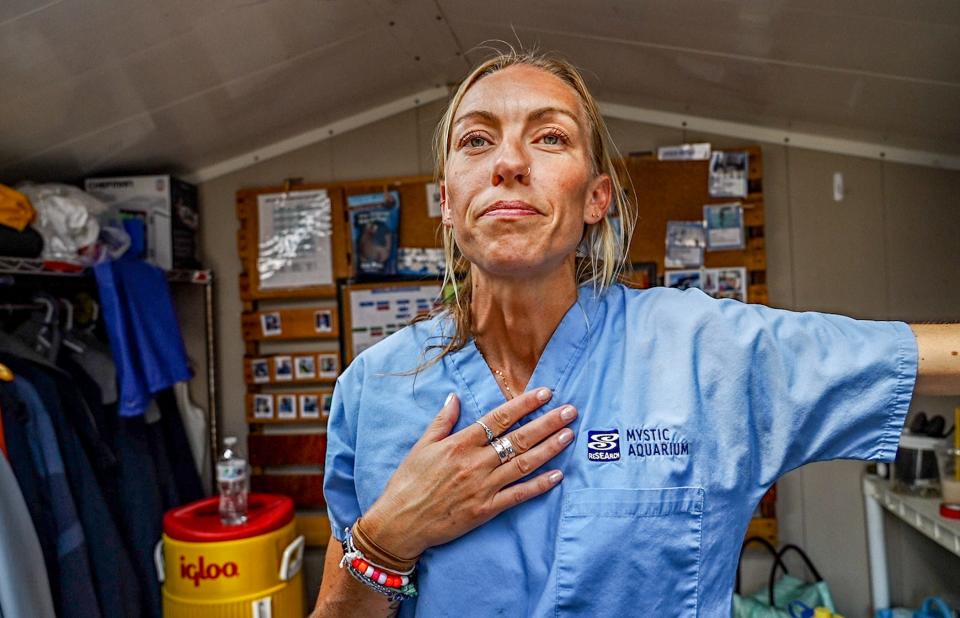
Some of the calls don’t warrant a full response, just a phone call back. For example, a seal sunning itself on a beach – which is normal behavior – sometimes triggers calls from people who are concerned that a seal is out of the water. In these cases, Callan calls them back as an educational opportunity.
But other calls require someone to get to the scene, usually a member of Mystic’s volunteer animal rescue program, to find the animal and bring it back to the aquarium.
Since 2018, Rhode Island has seen a 47% increase in annual marine mammal reports, which includes whales, dolphins, turtles and seals. And the seals on Block Island generate about 29% of the Rhode Island calls, according to the aquarium.
What it takes to find an animal in distress
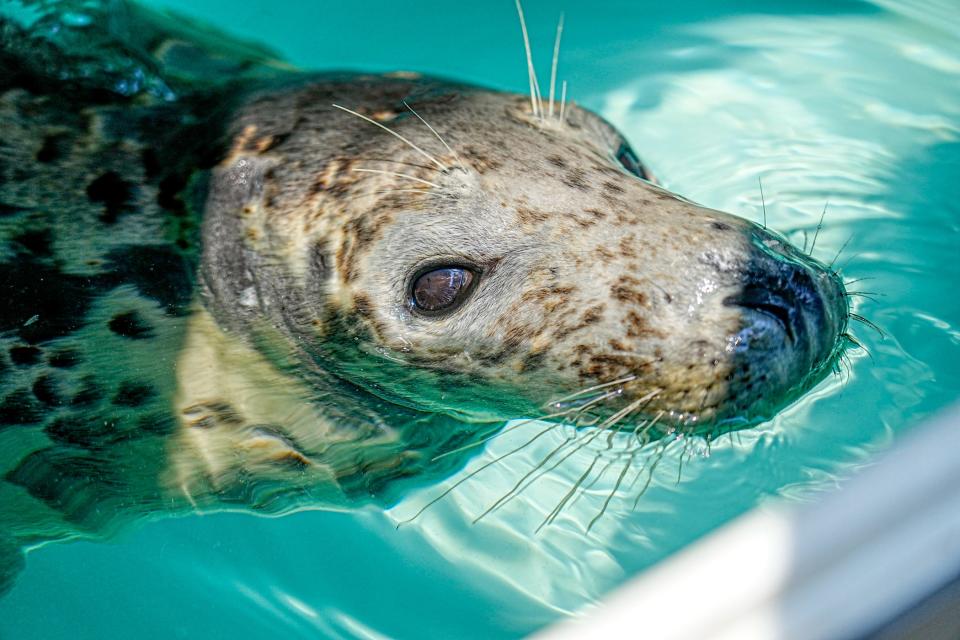
On a morning in June, Callan was still looking for that seal on Block Island that was entangled in fishing line. She had given a talk the day before at the Block Island Maritime Institute about the increase in the number of seals, which gave her the opportunity to spend the night on the island.
The talk had gone well – though audience questions about whether more seals meant worse fishing and more sharks gave her some consternation – but more important, it gave her a chance to look for the seal.
By mid-morning, however, she hadn’t had any luck.
The interns “are out there with binoculars looking for the seal among the others, so we’re hoping they find it, but ...” Callan said, trailing off. “It’s tricky, because if we approach them, they are all going to flush into the water, so we basically just have to sit and wait for the seal to be on its own.”
That day, all they did was sit and wait. Well, almost. The interns, Sophia Greisen and Ramique Porter, also found themselves chasing down people who were walking right past temporary signage telling people to stay 150 feet away from the seals' cluster at the point.
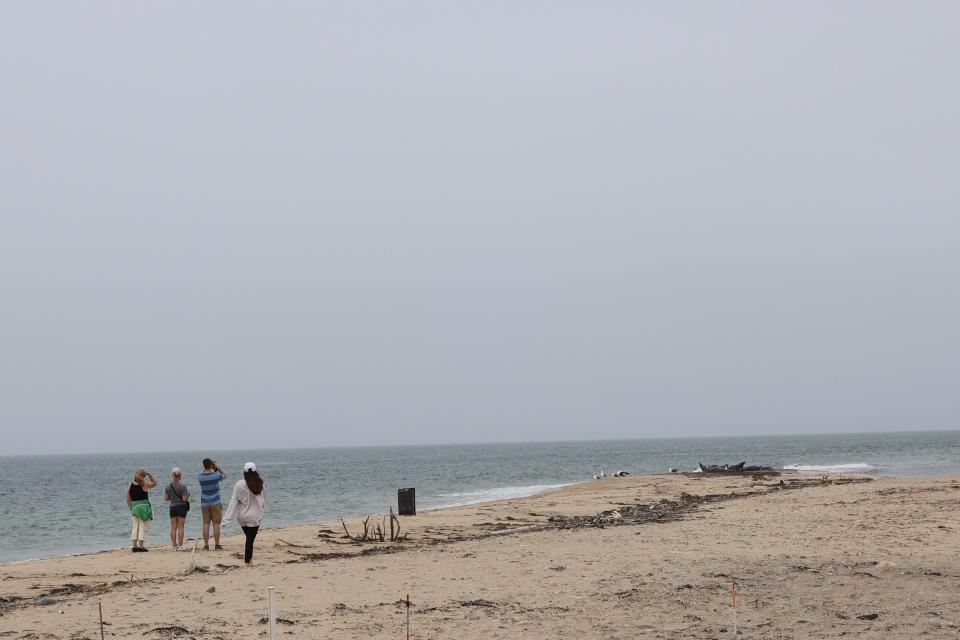
Most people are kind when the interns catch up to them, agreeing to step back and usually asking a few questions about the seals.
But there was frustration in knowing that if they hadn't been standing guard, the people would have kept walking. Except for a faded, chipped sign at the parking lot, the signage warning people to stay back is temporary, so it doesn’t get washed away in the waves and become pollution. At the end of the day, it comes down, and people start walking as close as they can get to the seals.
When the signage came down that day, the crew of volunteers wasn’t even 250 yards down the beach when they saw a group heading toward the point, well past where the signs once stood.
“The second we leave, this stuff happens,” Callan said.
In that same vein, it wasn’t more than an hour after Callan got off the Block Island ferry in Narragansett that her phone rang – someone had spotted the seal she'd just spent all day looking for. They sent pictures of the spotted seal, eyes half-closed, curled into the fetal position on the beach.
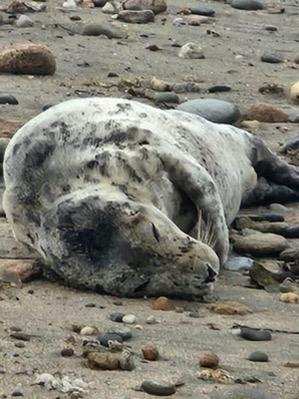
Callan tried to figure out how to get someone to the seal and get it on the 7 p.m. ferry, but the resources just weren’t there.
The same was true the next day, with a new photo of the seal curled up the beach.
And then on Friday, they got her. One of the interns corralled her into the dog kennel. Some beachgoers helped to carry the seal down the stretch of sand and then volunteered their car to take the seal (and the intern) to the ferry, with the Mystic team waiting on the other end.
How Mystic cares for the rescue animals
At the aquarium, the seal joins a crew of other rescue animals.
In the Milne Center for Ocean Science and Conservation, there’s “Spunky,” a critically endangered Kemp’s ridley sea turtle, who was released just after the seal arrived. Spunky, who was rescued off Cape Cod in November, got the nickname because he wouldn’t share his tank with other turtles. The rescued loggerheads in the other tanks don’t seem to mind the space.
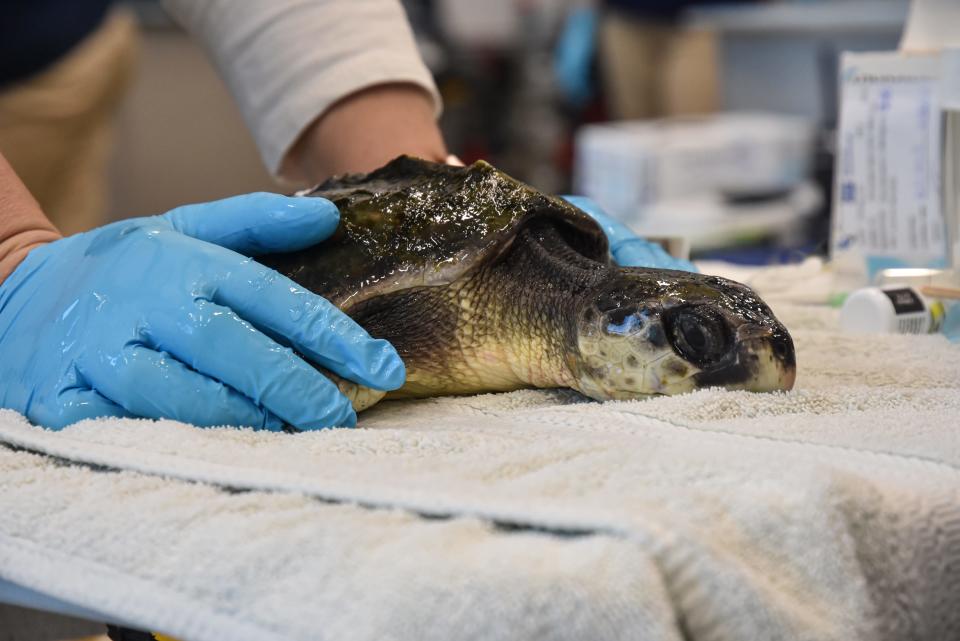
In the seal unit, built in the 1990s and meant to be temporary, there are other gray seals and one harbor seal. The harbor seal was rescued in Newport and has a parasite affecting her brain tissue that was passed on by opossum droppings. And there are a handful of gray seals that had their own entanglements, shark attacks and other medical issues.
The aquarium has a full vet clinic and a fully stocked pharmacy, so they can handle most issues the animals have. The seal rescued from Block Island will require amputation because of its wounds, for example.
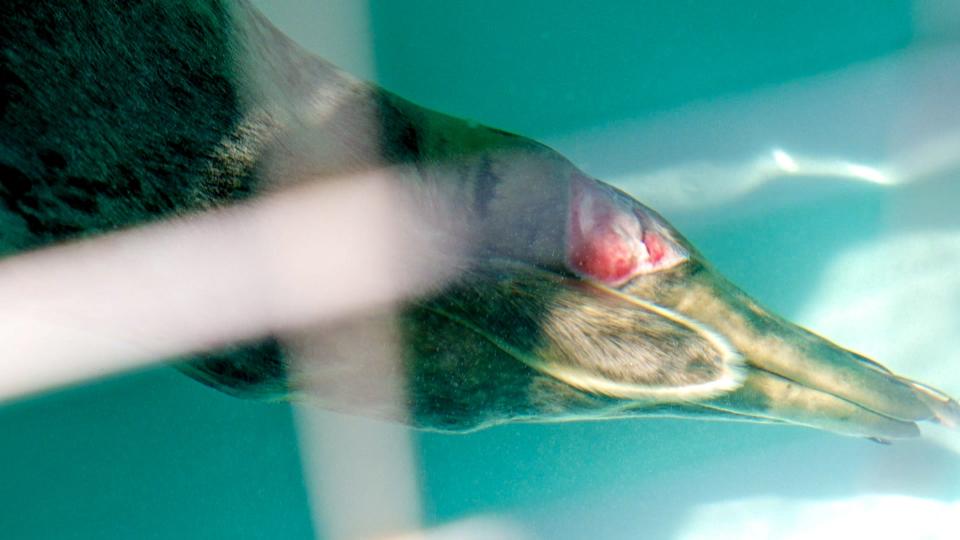
Here, with as little interaction with their human caretakers as possible, the seals will get a steady diet of Rhode Island-caught fish once they are up for eating and will have time to recover.
If all goes well, the seals will be cleared for release by the U.S. Department of Agriculture, the government agency that regulates marine mammal releases.
In April, a seal pup named Northlands was released while the "Today" show broadcast it live, and in May, Coasty, a seal rescued from Block Island, was released. Both releases took place at Blue Shutters Beach in Charlestown.
If any seals are not cleared for release, the aquarium will find homes for them, either at their facility or with another accredited institution.
Mystic Aquarium is looking for more support
When Mystic Aquarium set up its program decades ago, there wasn’t a year-round population of seals on Block Island. Cellphones – which have made calling in seal reports easier than ever – weren't invented yet. And there weren’t as many tourists – or as much plastic – interacting with sea life.
One seal can generate 60 calls, staff said.
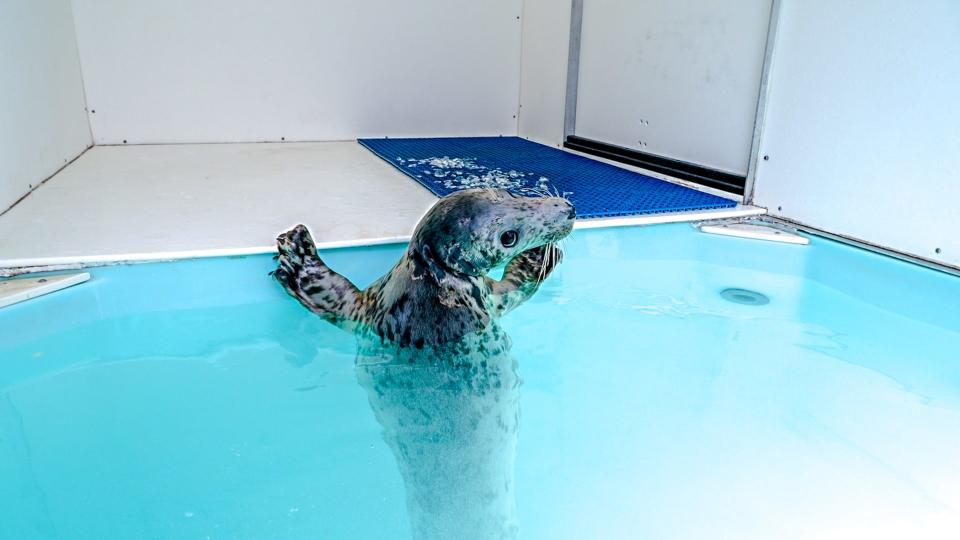
To keep up with the increasing demand, aquarium staff say they need more resources, such as more volunteers to help in the first responder program, an ATV to get to the seals at North Point, and increased funding.
Sharks in RI: The best way to get students into marine sciences? This camp is taking them shark fishing.
In the last legislative session, a bill was filed on their behalf asking for $500,000 to support their work, but it petered out. Instead, a budget item for a smaller amount was worked into the Department of Environmental Management’s budget, which they hope to use as a matching amount to obtain additional grant funding.
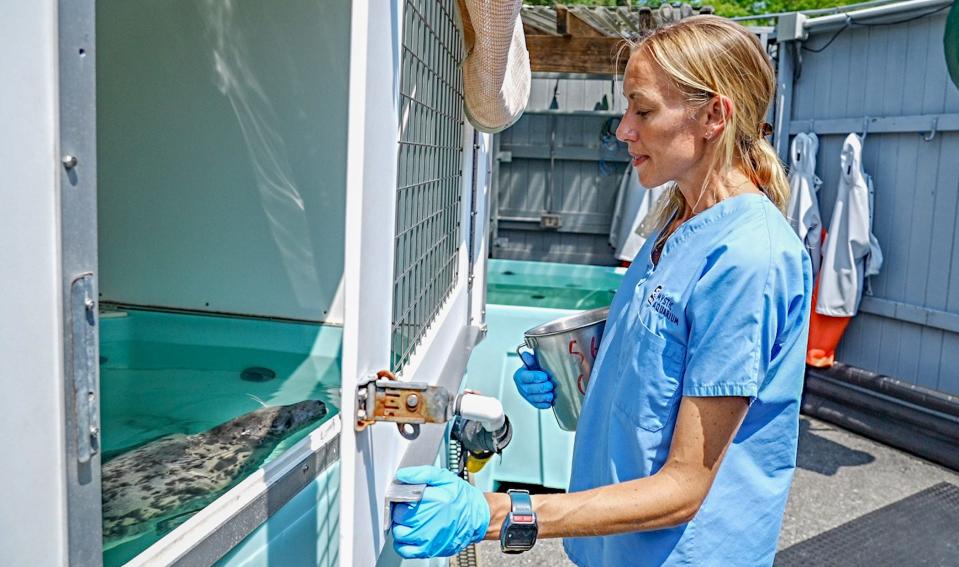
How to report a marine animal stranding in Rhode Island
If you see a stranded or dead marine animal or sea turtle, call Mystic Aquarium's 24-hour hotline at (860) 572-5955, ext. 107, and expect a return call. Keep at least 150 feet away from the animal, even if it's dead, and do not attempt to touch or feed it.
This article originally appeared on The Providence Journal: Mystic Aquarium animal rescue program handles Block Island seal calls

